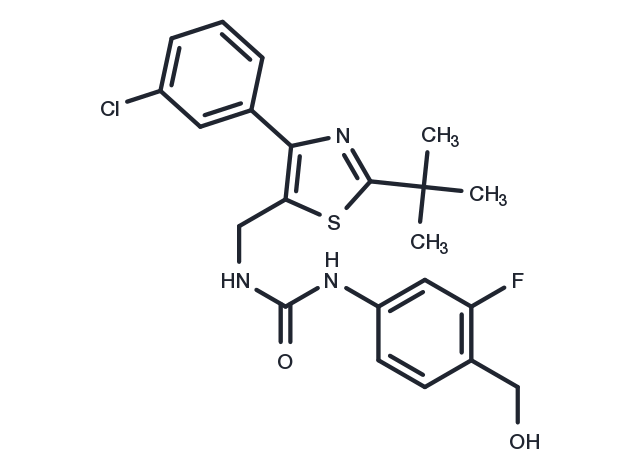Powder: -20°C for 3 years | In solvent: -80°C for 1 year


MDR-652 is a highly specific and efficacious agonist of nonpungent transient receptor potential vanilloid 1 (TRPV1) with Ki value of 11.4 nM and 23.8 nM for hTRPV1 and rTRPV1 respectively and EC50s for hTRPV1 and rTRPV1 are 5.05 and 93 nM respectively. MDR-652 is a potent topical analgesic.

| Pack Size | Availability | Price/USD | Quantity |
|---|---|---|---|
| 1 mg | In stock | $ 67.00 | |
| 2 mg | In stock | $ 98.00 | |
| 5 mg | In stock | $ 163.00 | |
| 10 mg | In stock | $ 247.00 | |
| 25 mg | In stock | $ 446.00 | |
| 50 mg | In stock | $ 673.00 | |
| 100 mg | In stock | $ 958.00 | |
| 1 mL * 10 mM (in DMSO) | In stock | $ 178.00 |

| Description | MDR-652 is a highly specific and efficacious agonist of nonpungent transient receptor potential vanilloid 1 (TRPV1) with Ki value of 11.4 nM and 23.8 nM for hTRPV1 and rTRPV1 respectively and EC50s for hTRPV1 and rTRPV1 are 5.05 and 93 nM respectively. MDR-652 is a potent topical analgesic. |
| Targets&IC50 | TRPV1 (rat):23.8 nM (Ki), TRPV1 (rat):93 nM (EC50), TRPV1 (human):11.4 nM (Ki), TRPV1 (human):5.05 nM (EC50) |
| In vivo | MDR-652 (0.5 and 5 mg/kg) displays a dose-dependent decrease of body temperature, supporting that MDR-652 displays TRPV1 agonism in the intact animal[1]. Potent analgesic activity was observed in models of neuropathic pain, and MDR-652 blocked capsaicin induced allodynia, showing dermal accumulation with little transdermal absorption. MDR-652 (5-10 mg/kg; i.p. and s.c.) blocks the neuropathic pain completely, indicating 100% maximum possible effect (MPE) [1]. MDR-652 has a promising topical pharmacokinetic profile[1]. MDR-652 displays weak systemic toxicity and is negative in assays of genotoxicity. In a single-dose toxicity study, the LD50 of MDR-652 is higher than 200 and 2000 mg/kg in i.p. and p.o. administration, respectively[1]. |
| Animal Research | MDR-652 (0.5 and 5 mg/kg; Administered intraperitoneally; 7 hours; ICR mouse) decreased body temperature in a dose-dependent manner. MDR-652 (1, 2, 5, and 10 mg/kg; Administered intraperitoneally and subcutaneously; 24 hours; Rats with spinal nerve ligation (SNL) model)The i.p. administration exhibited an excellent and dose dependent analgesic profile with an ED50 of 0.5-2 mg/kg. The subcutaneous injection (sc) also displayed an excellent analgesic outcome with maximum effect at 30 min after administration. |
| Molecular Weight | 447.95 |
| Formula | C22H23ClFN3O2S |
| CAS No. | 1933528-96-1 |
Powder: -20°C for 3 years | In solvent: -80°C for 1 year
DMSO: 249 mg/mL (555.86 mM), Sonification is recommended.
You can also refer to dose conversion for different animals. More
bottom
Please see Inhibitor Handling Instructions for more frequently ask questions. Topics include: how to prepare stock solutions, how to store products, and cautions on cell-based assays & animal experiments, etc.
MDR-652 1933528-96-1 Membrane transporter/Ion channel TRP/TRPV Channel Inhibitor Transient receptor potential channels MDR 652 neuropathic MDR652 analgesic TRP Channel TRPV1 activity pain hTRPV1 inhibit ligand inhibitor
